Human Stem Cells: The Body’s Fountain Of Youth?
Recently the US government announced that it was easing restrictions on the use of stem cells in medical research,
which generated much interest in companies on the cusp of this promising arena. Several
(such as Geron Corporation
(
GERN |
Quote |
Chart |
News |
PowerRating)) saw immediate gains in their stock prices,
based on enthusiasm for the potential healing powers of stem cells.Â
This announcement, although not greeted with
the fanfare used to introduce the sequencing of the entire human genome, I believe is equally
important. It will be financially beneficial for the companies and their investors, as well as medically beneficial for patients. I look for the British government to follow suit and ease restrictions on the use of stem cells from cloned human embryos to treat diseases. The British parliament is expected to meet later this year and its decision will renew interest in many of the companies I am about to mention.
In 1999, the editors of the prestigious journal
Science voted the advances in the use of stem cells as the top scientific advancement of the year. Will the use of stem cells turn out to be the miracle treatment for a variety of diseases, as some in the medical community believe? What companies will benefit
as research into the healing powers of stem cells progresses? The answers to these questions will have vast financial and medical implications. Let us get into some background first.
What are stem cells?
Stem cells are the most versatile, most flexible cells in our body. They are found in our blood,
bone marrow, and most of our organs. In the correct environment, they can do things that no other cells can do. Under the right stimuli, stem cells have the capacity to turn into any type of cell in
the body. When we are developing embryos, stem cells are directed to form all the mature organs we are born with. Any stem cell, given the right biological mix, can form into a nerve cell, a liver cell, a pancreatic
cell or bone-marrow cell. This fact has important implications for the treatment of damaged organs from any disease. Our bodies possess stem cells
both when developing and as adults. Scientists are now finding out that our adult organs have hibernating stem cells, ready to turn into an organ-specific cell when stimulated. The brain, once thought to have a finite number of neurons, houses stem cells which may turn into neurons if some are damaged by disease.
| “Embryonic stem cells are naked, wet biological clay. Adult stem cells… (can) form any cell, however not to the same degree…” |
Now, within the stem cell family, embryonic stem cells
(as opposed to adult stem cells) are considered to have the most potential in the treatment of
various types of diseases. The reason for this is that embryonic stem cells have
more flexibility when it comes to developing into any type of organ-specific cell. Adult stem cells are several steps down in the food chain and do not possess the versatility seen in embryonic stem cells.Â
A potter’s clay analogy is appropriate here. Before the clay is dry, it is very pliable and can be shaped into whatever the potter desires. As the clay starts to dry, its pliability diminishes to a point where it cannot be shaped into just anything anymore. Embryonic stem cells are naked, wet biological clay. Adult stem cells do possess the pliability to form any cell, however, not to the
same degree as embryonic stem cells.
What are the therapeutic implications of stem cells?
As I alluded to in the previous section, stem cells have the ability to replace any cell damaged by injury or
disease — any disease. Again, this has tremendous medical and financial implications. Scientists are already testing the use of stem cells to treat damaged nerve tissue in stroke patients and spinal cord injuries. There is some preliminary work using stem cells to form the mature cells in our body which produce insulin. Once new insulin-producing cells are formed, they can be transplanted into diabetic patients and function to eliminate the need for exogenous insulin. Diabetes is an enormous medical problem and financially a huge market for novel therapies. Heart disease, liver disease such as cirrhosis (a worldwide problem), Alzheimer’s disease and Parkinson’s can all
potentially be treated with stem cells. Organs damaged by the ravages of a growing cancer can potentially be replenished with stem cells. There is no disease immune to the potential medicinal properties of stem cells.
Today, scientists have the capacity to grow stem cells in the laboratory and stimulate them to grow into many different organ-specific cells. Much of today’s research has focused on the use of adult stem cells since the
Government has banned the use of embryonic stem cells for federally funded research. However, with the recent change in policy, the use of embryonic stem cells will take center stage simply because they have more biological potential. I believe in the next twelve months
there will be a marked increase in the demand for stem cells because more clinical research will take root. Companies involved in the procurement and development of stem cells will benefit greatly from this demand. Companies involved with cloning will also benefit, because stem cells can be cloned to make them available in mass quantities for research. By using cloning techniques, embryonic stem cells can also be made into immunological ghosts, keeping their medicinal powers without causing any side effects.Â
Who are the companies on the forefront of stem cell research today?
Geron Corporation
(
GERN |
Quote |
Chart |
News |
PowerRating)
Geron has been a leader in stem cell and cloning technology. The company is a supplier of stem cells and has the technology to grow stem cells in the lab. Geron scientists have also discovered a way to immortalize stem cells by the discovery of an enzyme called telomerase. By manipulating this cellular enzyme, Geron has the potential to generate an endless supply of stem cells ready to be used in research, organ transplantation, and clinical trials. The company is also experimenting with a cancer vaccine using the enzyme telomerase since it is also very prevalent in a variety of cancer cells. It recently announced some positive
pre-clinical data on this vaccine, resulting in a nice increase in the stock price.
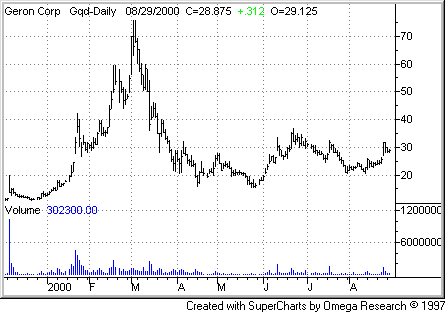
Geron also has a developing cloning program which may ultimately be used to clone organs for transplantation. The company has no products on the market and no ongoing late-stage clinical trials. However, I look for its stem-cell technology to be in high demand as more research is started and scientists start to unearth the potential uses of stem cells.
Aastrom BioSciences
(
ASTM |
Quote |
Chart |
News |
PowerRating)
Aastrom is in the business of producing adult stem cells from non-embryonic sources. The company has a patented technology called the Aastrom Replicated (TM) System which can supply stem cells in large quantities for medical research. Biotech and pharmaceutical companies alike wanting to get involved in stem cell research will need stem cell product to get started. Companies like Aastrom BioSciences supply that product and will be in demand as the clinical studies move forward.
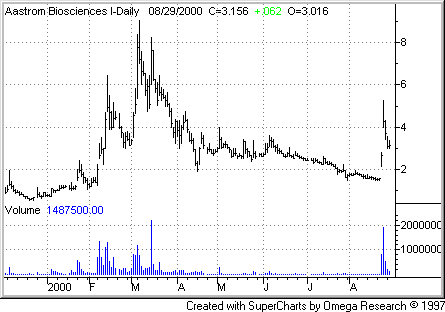
Incara
(
INCR |
Quote |
Chart |
News |
PowerRating)
This company has identified adult stem cells growing in liver tissue. It is carrying out research using these liver stem cells to treat several prevalent diseases which affect the liver. Cirrhosis, a worldwide problem with a high mortality, is a disease that causes irreversible damage to liver cells. Incara is doing research on the use of stem cells to treat cirrhosis and will start clinical trials in the early part of 2001. The company is also looking to test the use of stem cells to treat several childhood liver diseases with no effective treatment today.
StemCells
(
STEM |
Quote |
Chart |
News |
PowerRating)
This company is focusing on the use of stem cells to treat diseases of the liver, pancreas and nervous system. StemCells has developed a technology to reproduce both fetal and adult stem cells in the lab. The company, like many of its biotech brethren, currently has no products and no meaningful revenue. However, StemCells expects its unique approach to the mass production of stem cells will be in high demand now that the
Government restrictions on the use of embryonic stem cells has been eased.
Nexell Therapeutics
(
NEXL |
Quote |
Chart |
News |
PowerRating)
Nexell is developing technology to separate and grow stem cells in the lab for use in medical research. They are a supplier of stem cells and are perfecting a system to mass-produce stem cells for clinical trials. Again, like the previously mentioned company, Nexell expects its technology to experience significant growth over the next twelve months.
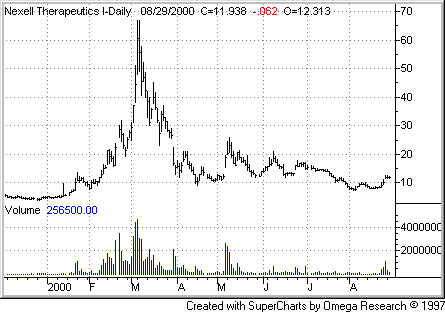
Other Biotechs
In addition to the specialized companies already mentioned, there are several larger biotech companies getting involved with stem-cell research.
Biogen, in conjunction with privately held Ontogeny, is involved with research focusing on the use of brain stem cells to treat nervous-system disorders. The company is looking at a protein which stimulates the conversion of neural stem cells in the brain to adult neurons in animals. Potentially, this protein could be used as a drug to repair damaged neurons present after a stroke or in Alzheimer’s disease. Â
ImClone Systems
(
IMCL |
Quote |
Chart |
News |
PowerRating), a company involved in novel treatments for cancer, is looking at identifying the genes responsible for the replication of stem cells. The company is doing this
pre-clinical research with Princeton University scientists and hopes to create a database of genetic information responsible for the reproduction and identification of all types of stem cells.Â
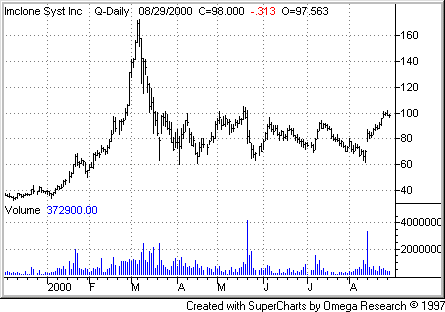
Ariad Pharmaceuticals
(
ARIA |
Quote |
Chart |
News |
PowerRating), a genomics company involved in identifying gene function and the proteins expressed, is also developing a technology that could be used to grow and reproduce stem cells for medical research.
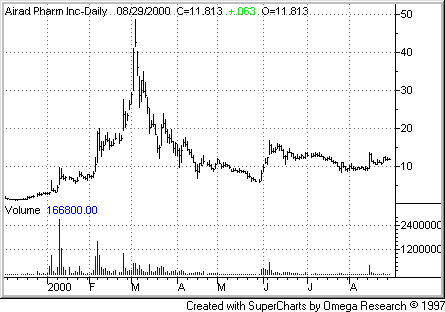
Summary
I look for research on the medicinal use of human stem cells to greatly accelerate over the next twelve months. This is, in part,
due to the Government’s recent decree on being willing to fund research using embryonic stem cells. It is also due to the incredible potential
of stem cells to treat and cure a variety of diseases — a potential that is just beginning to be tapped. Stem cells will be in demand and so will the companies involved in their production.
Do you have a follow-up question about something in this column or other questions about trading stocks, futures, options or funds? Let our expert contributors provide answers in the TradingMarkets Question & Answer section! E-mail your question to questions@tradingmarkets.com.
For the latest answers to subscriber questions, check out the Q&A section, linked at the bottom-right section of the TradingMarkets.com home page.
